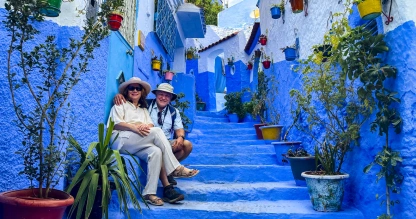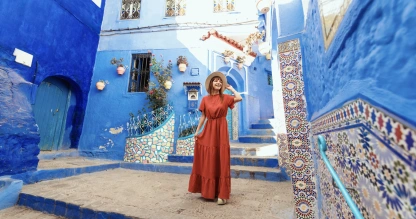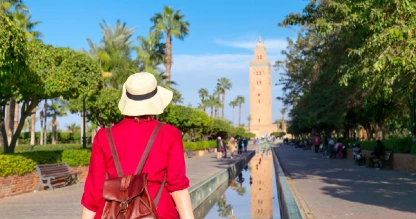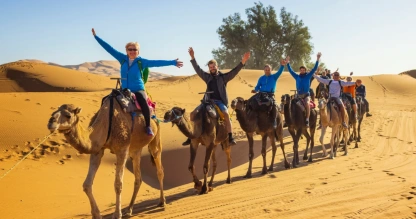
Discover the city of Rabat
Rabat serves as Morocco's elegant capital, a title it earned in 1955 after breaking free from French rule. This beautiful city sits where the Wadi Bou Regreg meets the Atlantic coast.
The Almohads built Rabat in the 12th century, and today it showcases an amazing mix of old-world charm and modern city design. This Moroccan capital stands among the country's four Imperial cities, and its medina has earned UNESCO World Heritage status. Tourists who want to learn about Rabat can discover two distinct worlds. The old town still shows off its Almohad walls and the magnificent 144-foot Hassan Mosque minaret that started taking shape in 1184. The new town, built during French rule from 1912 through the 1930s, represents one of Africa's boldest modern urban projects of the 20th century.
A Brief History of Rabat
Rabat's story goes back substantially further than its role as the capital city in Morocco. This 3000-year-old Phoenician trading post called Shallat evolved into the Roman city of Sala Colonia during the first century BC. The Romans turned it into a crucial Atlantic naval outpost.
From Roman Sala to Islamic Rabat
The Roman influence faded in the 5th century, leaving Sala mostly deserted until Muslim Arabs arrived in the 7th century. The area became important again in the 10th century. The Umayyads built a ribat (fortified monastery) to protect against hostile Berber tribes. The city of Rabat got its name from this military outpost, since "Ribat" means "fortified camp" in Arabic.
The Almohad dynasty revolutionized Rabat starting in 1150. Caliph Abd al-Mu'min constructed a new kasbah that's now part of the Kasbah of the Udayas. Caliph Yaqub al-Mansur (1184-1199) had grand plans to make Ribat al-Fath ("Camp of Victory") an imperial capital. He built massive walls, impressive gateways, and started the Hassan Tower project. This tower would have been part of one of the world's largest mosques if completed.

The Corsair Republic and Alawi Rule
Rabat's story took an interesting turn in 1609. About 2,000 Moriscos (Muslims forced out of Spain) made this area their home. Rabat and its neighbor Salé joined forces in 1627 to create the independent Republic of Bou Regreg. The republic became famous for its corsair attacks on European ships. A 16-member Diwan (council) ran the republic and kept their records in Spanish.
Alawi sultan al-Rashid brought the republic's independence to an end in 1666. Pirates continued their raids until the early 19th century. The city grew under Moulay Isma'il's rule (1672-1727) as he expanded the kasbah. Sidi Muhammad ibn Abdallah (1757-1790) built the Dar al-Makhzen royal palace, which still serves as Morocco's monarchy's official residence.
French Protectorate and Modern Capital
The 1912 Treaty of Fez changed everything. Resident-General Hubert Lyautey picked Rabat as the French Protectorate's capital. He loved Rabat's coastal location, pleasant climate, and its closeness to Casablanca. Urban planner Henri Prost designed Rabat's modern quarter in 1913. His design became a model of colonial urban planning that protected historical monuments while bringing in new public health ideas. King Mohammed V decided to keep Rabat as the capital after independence in 1956. This choice secured Rabat's place as modern Morocco's political and administrative center.

Exploring the Neighborhoods of Rabat
Rabat's neighborhoods showcase a perfect mix of old traditions and modern life. Each area gives visitors something different to experience, from ancient streets to modern urban spaces.
The Medina and Kasbah of the Udayas
The capital city in Morocco has a compact medina at its core that feels more organized and calmer than other Moroccan cities. Visitors can easily walk through its broad, clean streets without feeling rushed. The historic Kasbah of the Udayas sits proudly on a hilltop with stunning views of the Atlantic Ocean and Bou Regreg River.
The Almohads built this walled citadel in the 12th century. Its blue and white houses look similar to Chefchaouen and attract photographers from everywhere. The kasbah is home to Morocco's oldest mosque, beautiful Andalusian Gardens from the French Protectorate era, and the National Jewelry Museum located in Sultan Mulay Ismail's former home.

Agdal, Hay Riad, and Souissi
Agdal stands out as one of Rabat's liveliest areas where young people meet at cafés and restaurants. This modern district has boutiques, trendy spots, and the 17-hectare Jardin d'Essais garden built in 1914. Hay Riad, which grew in the late 1970s, has become Morocco's top business and residential area.
Many diplomatic missions and multinational companies call it home. Just 20 minutes from the historic medina, the area features luxury villas with modern designs, private gardens, and top-notch security systems. Souissi ranks among Rabat's most desirable neighborhoods. Its elegant villas and green spaces make it perfect for families who want a quiet lifestyle.

Salé and the Bou Regreg Riverfront
Salé sits across the Bou Regreg River as Rabat's twin city. Though now basically a suburb of the capital, its rich history dates back to the 10th century. Salé's walled medina has many impressive sites.
These include the Grand Mosque built between 1163 and 1184, a beautifully restored Merenid-era Madrasa, and Salé's patron saint Sīdī ʿAbd Allāh ibn Ḥasan's mausoleum. The ambitious Bouregreg Valley project now links these historic sister cities. This 6,000-hectare riverfront development brings new homes, cultural venues, better transport, and restored historic buildings to the area.
Top Things to Do in Rabat
The city of Rabat is full of cultural treasures. Morocco's administrative center has rich historical layers and neighborhoods that offer enriching experiences to its visitors.
Visit the Hassan Tower and Mausoleum of Mohammed V
The Hassan Tower and the Mohammed V Mausoleum are among the top attractions in Rabat, perched on one of the city’s highest points. The unfinished 44-meter minaret and the stunning mausoleum, with its white onyx sarcophagi, zellige tiles, and golden vaulted ceiling, showcase Morocco’s artistry and heritage. Include these highlights in your Morocco travel packages for an unforgettable cultural experience.

Stroll through the Andalusian Gardens
The French-designed gardens sit within the Kasbah des Oudayas and pay tribute to southern Spain's horticultural heritage. Tall palms, sweet-smelling citrus trees, vibrant bougainvillea, and peaceful fountains fill these spaces. These gardens become a peaceful haven during hot afternoons.

Explore the Chellah Necropolis
This 7-hectare archeological site includes an ancient Roman city and Marinid necropolis. A one-kilometer Marinid wall protects Chellah, which became a UNESCO World Heritage Site in 2012.

Attend the Mawazine Music Festival
The 2025 Mawazine Festival has grown into Morocco's biggest music event, attracting 3.75 million people and becoming the world's largest music festival. The festival features 90 acts across 7 stages. Past performances included Rihanna who drew 150,000 fans and Christina Aguilera who attracted 250,000 attendees.
Take a closer look at Moroccan art at the Mausoleum of Mohammed V
This 8-year-old museum opened as Morocco's first major museum in over 100 years and showcases works from more than 200 Moroccan artists. The museum's collection features pieces from the early 20th century to modern times in various artistic styles.

Modern Life in the Capital City of Morocco
Rabat combines historical charm with modern living as an eco-friendly capital filled with green spaces and a lively urban atmosphere.
Education and Universities
Morocco's higher education system has 13 public universities, 8 private universities, and 211 private institutes. Mohammed V University stands as Rabat's top educational institution and holds positions in several global rankings. The International University of Rabat stands out as a public-private partnership and remains one of the country's few public universities that charges tuition. The Royal Institute of Amazigh Culture started its mission in 2001 to promote Berber languages and culture.
Transport and Connectivity
The Rabat-Salé tramway creates a continuous connection between both cities through 19 km of track and 32 stations. This network links key spots like administrative buildings, universities, and hospitals. Blue petit taxis offer affordable rides starting at seven dirhams throughout the city. The city's excellent rail connections through the ONCF network make travel to other major cities convenient.
Cultural Institutions and Events
Zaha Hadid's Grand Théâtre de Rabat opened its doors in 2021 and now hosts concerts and international events. Villa des Arts welcomes visitors with free admission to art exhibitions and cultural events.
Essential Tips for Visiting Rabat
When visiting Rabat, Morocco’s laid-back capital, plan to explore both its modern avenues and historic medina. Wear comfortable shoes for walking through sites like the Kasbah of the Udayas and Hassan Tower.
Public transport is reliable, but taxis are often the quickest way to get around—just be sure to agree on the fare in advance. Rabat’s coastal breeze can be cool, so carry a light jacket even in warmer months. Finally, take time to enjoy the city’s cafés and seaside promenades, where you can experience the relaxed pace that sets Rabat apart from Morocco’s busier cities.
Rabat is more than just Morocco's capital - it's a living museum. Ancient walls line modern boulevards, traditional crafts thrive next to modern art, and historic monuments stand beside innovative architecture.

FAQS
Q1. Is Rabat safe for tourists?
Yes, Rabat is considered one of Morocco’s safest cities, with a calm atmosphere and a relaxed pace compared to Casablanca or Marrakech. Like anywhere, just keep an eye on your belongings in crowded areas.
Q2. How long should I spend in Rabat?
Two to three days is ideal to enjoy the highlights—Hassan Tower, the Kasbah of the Udayas, the medina, and the city’s beaches—without feeling rushed.
Q3. What is Rabat most known for?
Rabat is famous for being Morocco’s capital, blending modern life with rich history. Its UNESCO-listed medina, Hassan Tower, and the Royal Palace are among its most iconic landmarks.
Q4. What traditional food should I try in Rabat?
Be sure to try seafood dishes along the coast, as well as Moroccan staples like tagine, couscous, and pastilla—a savory-sweet pie often filled with pigeon or chicken.
Q5. What to buy from Rabat?
Rabat’s medina is great for handmade rugs, pottery, leather goods, and traditional jewelry. You’ll also find unique crafts that reflect the city’s Andalusian heritage.
Ready to discover Morocco's magic? Explore our Morocco Travel Packages and enjoy the best of Middle East trips!













